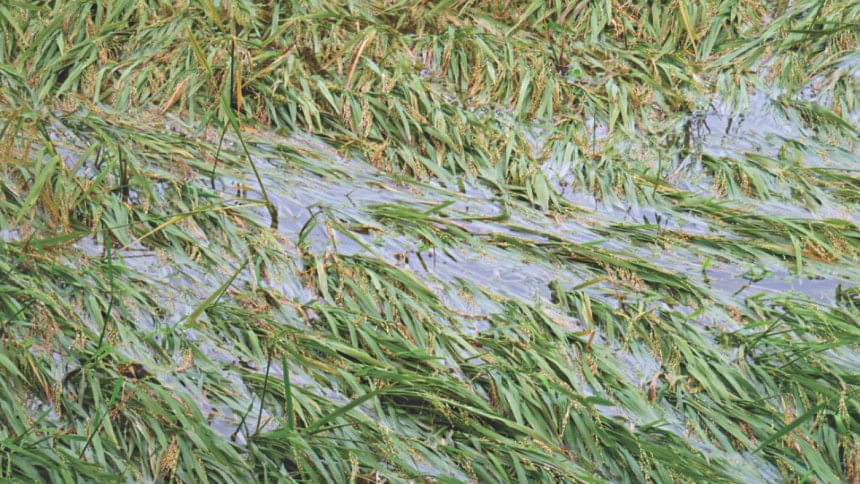Big blow to Boro

For the first time in recent years, Bangladesh is set to experience a less productive rice season owing to a huge loss of Boro crops.
Back-to-back disasters -- flashfloods, intense rainfall and fungal disease blast attacks -- have come as a blow to Boro, the biggest of the country's three rice seasons. The other two seasons are Aus and Aman.
Following the first strike of flashflood in Sunamganj and few other adjoining haor-rich districts, the Department of Agricultural Extension estimated a crop loss of six lakh tonnes with Boro on two lakh hectares gone under water.
The DAE, however, is reassessing the Boro losses as reports on new areas being submerged after haor embankments gave way to flashfloods continue to come, officials from the agriculture ministry and the DAE told The Daily Star yesterday.
After an unusually early flashflood struck the backswamp of the northeastern regions late last month, the government had said Boro output would be some 4.5 lakh tonnes less than the 1.91 crore tonnes production target.
But with flashfloods inundating fresh haor areas and incessant and early rainfalls submerging many other parts of the country, the probable gap now also required to be rechecked.
DAE Field Services Wing Director Chaitanya Kumar Das yesterday acknowledged reports also came in from some other parts of the country other than the haor zones that farmers were harvesting Boro ahead of the full-ripening stage to save the crop from completely being submerged in rain water.

He said fungal disease blast also struck rice in some districts but, "to what extent it would hamper the production is yet to be assessed."
Prof M Bahadur Meah, a preeminent plant pathologist, told The Daily Star yesterday that crops were getting sterile due to neck blast attacks on different Boro growing regions of the northern, southern and central districts.
"Early and intense rainfalls in late March and in April created a favorable atmosphere for fungi to attack the necks of rice plants during the grain formative stage. Through relevant government departments, we sent out messages to farmers to spray anti-blast fungicides," said Bahadur, who teaches plant pathology at the Bangladesh Agricultural University (BAU) in Mymensingh.
He feared a substantial crop loss this year because of the rice neck blast. He recommended that the government provides farmers with subsidised fungicides as many poor farmers can ill afford the high fungicide prices.

Blast is caused by the fungus Magnaporthe oryzae and can affect all above ground parts of rice plant; leaf, collar, node, neck, parts of panicle, and sometime leaf sheath.
Seeking to redress blast, the agriculture ministry is going to hold a consultative workshop involving all relevant departments and representatives from the international community early next week.
The production loss in Boro came at a time when public granaries were having one of the lowest stocks of food grains in six years.
Total food grain stocks stood at 5.46 lakh tonnes, the lowest since fiscal 2009-10, shows data from the food ministry. The failure to reach the government's food grains procurement target and increased food distribution brought down the rice stock to 3.59 lakh tonnes only.
A newly released United States Department of Agriculture (USDA) report also noted that Bangladesh's rice stock in the public food distribution system got nearly halved compared to last year's stock of this time.
USDA said, the government distributed 1.1 million tonnes of rice to the poor through various programmes from July last year till this March 16, which was a rise by 56 percent year on year.
Against the backdrop of the situation, market sources fear that the government would ill-afford going for any large-scale relief and OMS (Open Market Sale) operations for flashflood victims in the vast haor regions, unless it made quick strides in replenishing the granaries.
And this development comes at a time when importers and rice millers are pressing the food ministry to take steps to reduce import tariff to ensure adequate domestic supplies, but the government believes domestic supplies of rice in the wholesale market are still sufficient.
Besides, the food ministry also plans to go for a 1.5 million tonnes of rice and paddy procurement drive from next month.
To stop fall in rice prices and protect the domestic market from cheap rice imports from India, the government last year slapped a 25 percent import tariff, which is still in force with millers and importers pressing the government to reduce the tax.
The government, however, has apparently a better plan up its sleeve -- it wants to expand high yielding varieties and African drought-tolerant Nerica variety in coming Aus rice season by distributing seed and fertilizer and by subsidising irrigation to over 200,000 small and marginal farmers.
Officials say this would help recoup, to some extent, the loss of Boro and stabilise the market prices of rice, which according to USDA, have gone up to a three-year high.
USDA stated that the wholesale and retail prices of rice in March were Tk 36 and Tk 38 per kilogram, which is 38 and 28 percent higher than they were last year.
It notes that despite good harvest of the Aman season rice (which is marketed in December), prices of milled rice in 2016-17 soared to a three-year high. Some sources claim the leading rice traders are sitting on stocks to create an artificial shortage and thus push up prices, said USDA, adding that "Since the private sector provides no official records of grain stocks, this claim is not easily confirmed or disputed."

 For all latest news, follow The Daily Star's Google News channel.
For all latest news, follow The Daily Star's Google News channel. 




Comments